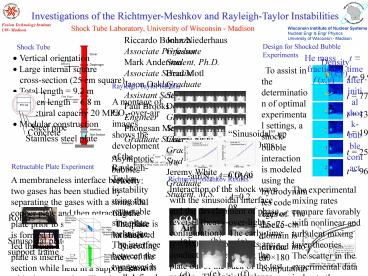Investigations of the Richtmyer-Meshkov and Rayleigh-Taylor Instabilities - PowerPoint PPT Presentation
1 / 1
Title:
Investigations of the Richtmyer-Meshkov and Rayleigh-Taylor Instabilities
Description:
A membraneless interface between two gases has been studied by separating the ... A montage of CO2-over-air images shows the development of the Rayleigh-Taylor ... – PowerPoint PPT presentation
Number of Views:24
Avg rating:3.0/5.0
Title: Investigations of the Richtmyer-Meshkov and Rayleigh-Taylor Instabilities
1
Investigations of the Richtmyer-Meshkov and
Rayleigh-Taylor Instabilities
Fusion Technology Institute UW- Madison
Wisconsin Institute of Nuclear Systems Nuclear
Engr Engr Physics University of Wisconsin -
Madison
Shock Tube Laboratory, University of Wisconsin -
Madison
Riccardo Bonazza Associate Professor Mark
Anderson Associate Scientist Jason
Oakley Assistant Scientist Paul
Brooks Engineer Phongsan Meekunnasombat Graduate
Student, Ph.D.
John Niederhaus Graduate Student, Ph.D. Brad
Motl Graduate Student, M.S. Devesh
Ranjan Graduate Student, M.S. Chaine
Selig Graduate Student, M.S. Jeremy
White Graduate Student, M.S.
Design for Shocked Bubble Experiments
Shock Tube
Vertical orientation Large internal square
cross-section (25 cm square) Total length 9.2
m Driven length 6.8 m Structural capacity
20 MPa Modular construction
t time after initial shock-bubble contact
He mass fraction f (x,y)
Density r(x,y)
To assist in the determination of optimal
experimental settings, a shock-bubble interaction
is modeled using the hydrodynamics code Raptor.
The 2575-cm domain is divided into 60180
computational cells with two levels of adaptive
mesh refinement at a refinement ratio of four.
The upper portion of the domain is filled with
shocked gas, and the lower portion with
unshocked, quiescent gas. After the problem is
initialized, the shock wave propagates downwards
and interacts with a bubble of He (modeled as a
circle in this 2D case). The bubble is
accelerated and deformed under the influence of
the shock and breaks off into two spinning
fragments. The post-shock bubble development is
studied so that electronic trigger times and
diagnostics for the experiment may be configured
appropriately.
t 9.97 ms
Rayleigh-Taylor Results
t 77.44 ms
CO2
A montage of CO2-over-air images shows the
development of the Rayleigh-Taylor instability
using the retractable sine plate technique. The
interface between the two gases is well defined
up to 260 ms. For studying a predominantly
single-mode interface this technique works for
this gas pair up to approximately 120 ms. There
is excellent agreement with the theoretical
bubble velocity for two low Atwood number (A) gas
pairs.
air
45.7 cm
25.4 cm
t 136.7 ms
Steel pipe
Concrete
t 195.2 ms
Sinusoidal up to t 120 ms
Stainless steel plate
t 257.3 ms
Asymptotic bubble velocity
Alon et al. Phys. Rev. Let., vol 72, p 2867,
1994 Gardner et al. Phys. Fluids, vol 31, p 447,
1998
Retractable Plate Experiment
t 966.4 ms
CO2/air A0.208
air/N2 A0.0169
A membraneless interface between two gases has
been studied by separating the gases with a
sinusoidal copper plate and then retracting the
plate prior to shock arrival. The plate is
formed from an initially flat sheet fed through a
pair of rollers. The plate is inserted in the
interface section while held in a support frame
with sine wave slot. The plate is retracted,
either pneumatically or with a linear electric
motor, and the gases come in contact with one
another. Using a heavy gas over a light gas
configuration, the Rayleigh-Taylor instability
develops first, resulting in a growth of the sine
wave amplitude, and at a predetermined time, the
interface is shocked.
Richtmyer-Meshkov Results
Interaction of the shock wave with the sinusoidal
interface and the development of phase reversal
(heavy-over-light configuration). The early-time
(t lt 100 ms) experiments are conducted by
retracting the plate out of the back of the test
section. The initially planar shock that is
transmitted through the interface is distorted
due to the geometry of the interface. Fine scale
mixing is observed during the phase reversal
process, shown below.
The experimental mixing rates compare favorably
with nonlinear and turbulent mixing layer
theories. The scatter in the experimental data
is due to the difference in interface amplitude
from experiment to experiment (2.29-3.29 mm) and
three-dimensional effects that are not visible in
the plane of the laser sheet.
The interface is visualized by seeding one of the
gases with smoke particles and then illuminating
a 2D slice with a laser sheet. The initial
conditions are imaged with a 512532 pixel array,
100 fps CCD camera, and the shocked image is
captured with 10241024 pixel array camera. The
NdYag laser is pulsed after a predetermined
delay from the shock pressure transducer located
above the test section.
Ages of shocked interfaces (a) Pre-shocked
(b) 5 ms after initial shock acceleration (c)
36 ms (d) 39 ms (e) 646 ms (f) 1.80 ms
Rollers
CO2
Air
(a)
(b)
Sinusoidal plate in support frame
(c)
Sadot et al. Phys. Rev. Let., vol 80, p 1654,
1998 Dimonte et al. Phys. Plasmas, vol 7, p 2255,
2000
(e)
(f)
(d)

